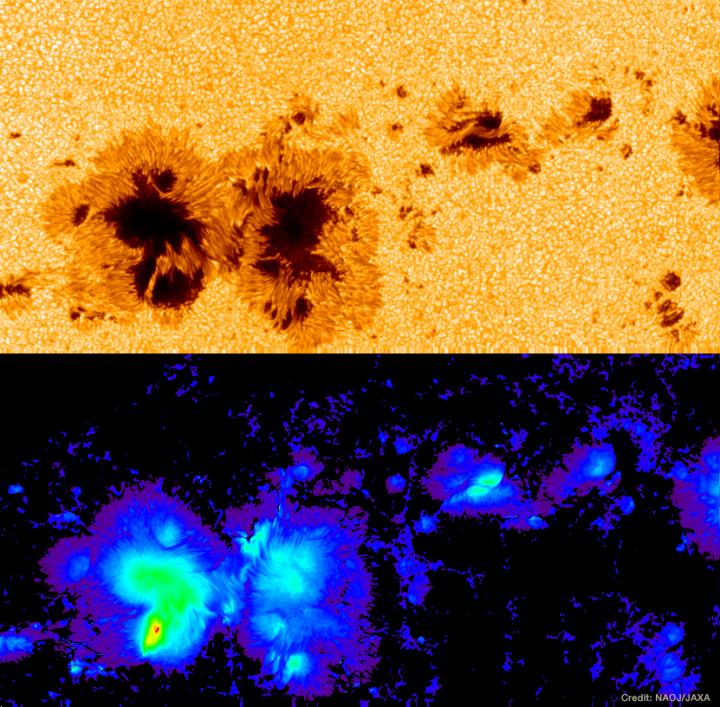HINODE captures record breaking solar magnetic field

(top) Visible light continuum image. (bottom) Magnetic field strength map. The color shows the field strength, from weak (cool colors) to strong (warm colors). Red indicates a location with a strength of more than 6,000 gauss (600 mT). Credit: NAOJ/JAXA
A sunspot usually consists of a circular dark core (the umbra) with a vertical magnetic field and radially-elongated fine threads (the penumbra) with a horizontal field. The penumbra harbors an outward flow of gas along the horizontal threads.
The darkness of the umbrae is generally correlated with the magnetic field strength. Hence, the strongest magnetic field in each sunspot is located in the umbra in most cases.
Joten Okamoto (NAOJ Fellow) and Takashi Sakurai (Professor Emeritus of NAOJ) were analyzing data taken by the Solar Optical Telescope onboard HINODE, when they noticed the signature of strongly magnetized iron atoms in a sunspot.
Surprisingly the data indicated a magnetic field strength of 6,250 gauss (*1). This is more than double the 3,000 gauss field found around most sunspots. Previously, magnetic fields this strong on the Sun had only been inferred indirectly. More surprisingly, the strongest field was not in the dark part of the umbra, as would be expected, but was actually located at a bright region between two umbrae.
HINODE continuously tracked the same sunspot with high spatial resolution for several days. This is impossible for ground-based telescopes because the Earth's rotation causes the Sun to set and night to fall on the observatories.
These continuous data showed that the strong field was always located at the boundary between the bright region and the umbra, and that the horizontal gas flows along the direction of the magnetic fields over the bright region turned down into the Sun when they reached the strong-field area.
This indicates that the bright region with the strong field is a penumbra belonging to the southern umbra (S-pole). The horizontal gas flows from the southern umbra compressed the fields near the other umbra (N-pole) and enhanced the field strength to more than 6,000 gauss.
Okamoto explains, “HINODE's continuous high-resolution data allowed us to analyze the sunspots in detail to investigate the distribution and time evolution of the strong magnetic field and also the surrounding environment. Finally, the longtime mystery of the formation mechanism of a stronger field outside an umbra than in the umbra, has been solved.”
(*1) 10 gauss = 1 milli-tesla.
Media Contact
All latest news from the category: Physics and Astronomy
This area deals with the fundamental laws and building blocks of nature and how they interact, the properties and the behavior of matter, and research into space and time and their structures.
innovations-report provides in-depth reports and articles on subjects such as astrophysics, laser technologies, nuclear, quantum, particle and solid-state physics, nanotechnologies, planetary research and findings (Mars, Venus) and developments related to the Hubble Telescope.
Newest articles

Properties of new materials for microchips
… can now be measured well. Reseachers of Delft University of Technology demonstrated measuring performance properties of ultrathin silicon membranes. Making ever smaller and more powerful chips requires new ultrathin…

Floating solar’s potential
… to support sustainable development by addressing climate, water, and energy goals holistically. A new study published this week in Nature Energy raises the potential for floating solar photovoltaics (FPV)…

Skyrmions move at record speeds
… a step towards the computing of the future. An international research team led by scientists from the CNRS1 has discovered that the magnetic nanobubbles2 known as skyrmions can be…





















